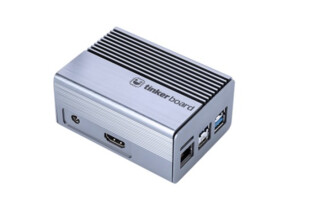ASUS IoT Tinker System 2 Excels As Network Analyzer Backbone
November 21, 2023
Sponsored Story

An embedded computer plays a key role in a network analyzer application, as it performs a variety of tasks related to network monitoring, analysis, and management. Some common tasks performed by that embedded computer include the following:
- Packet capture and analysis: Network analyzers often need to capture data packets to analyze network traffic. The embedded computer can be equipped with network interfaces, typically Ethernet, and specialized software to capture packets, dissect their contents, and perform in-depth analysis. This allows network administrators to monitor traffic, identify issues, and troubleshoot network problems.
- Protocol decoding: Network analyzers need to understand and decode various network protocols, such as TCP/IP, HTTP, and DNS. The embedded computer interprets these protocols and provides insights into the data flowing through the network.
- Traffic monitoring: Embedded computers can continuously monitor network traffic and generate reports on bandwidth use, traffic patterns, and anomalies. This information helps network administrators optimize network performance and detect suspicious or unauthorized activities.
- Security functions: Network analyzers often include security features to detect and mitigate threats. Embedded computers can run intrusion detection systems (IDS) and intrusion prevention systems (IPS) to identify and respond to security breaches in real-time.
- Remote management: Network analyzers can be remotely managed and configured. With the embedded computer serving as a control center, administrators can access and control the analyzer remotely.
- Data storage and logging: Embedded computers can store all captured network data and logs locally.
- Real-time monitoring and alerts: The embedded computer can process data in real-time and generate alerts or notifications when predefined conditions are met, such as excessive bandwidth utilization, security threats, or specific network events.
- Customization and extensibility: If properly configured, embedded systems can be customized and extended to meet specific network analysis requirements. Additional hardware modules or software plugins can enhance the network analyzer’s capabilities.
- Energy efficiency: Embedded computers can be designed with power-efficient components to minimize energy consumption, making them suitable for deployment in remote or environmentally sensitive locations.
In a real-world example that happens to be in Korea, one vendor, Soul Systems, deployed an Asus IoT Tinker System 2 to handle network performance evaluation. Soul Systems specializes in network operation and management systems that proposes “one-click solutions.” Typical environments the company works in include network virtualization, 5G, cloud, IoT, and edge computing.
In this example, Soul Systems required a real-time response, security, and tech support. To address this demand for data security and quality assessment, the vendor developed a system called Lampad, which employs a Tinker System 2 at its core. The Lampad not only collects and scrutinizes network packets, but also provides a comprehensive evaluation of network performance and failure triggers.

Network downtime can severely disrupt operation and result in substantial financial losses. Lampad streamlines the troubleshooting and recovery process through its near-instantaneous root cause analysis. In one deployment, it has reduced mean time to repair by over 90% when compared to previous conventional systems. Note that the previous computer deployed by the customer for this application was based on a Raspberry Pi 4, which provided no technical support, no longevity support, and was in the midst of supply difficulties.
Documenting the root causes and preventive measures is critical in averting the recurrence of issues. Lampad generates a diagnostic report with a single click to pinpoint causes and offers a troubleshooting guide to preempt future failures. For example, when the Lampad system is connected to a network section's switch, it instantly measures the section's performance and quality.
In this scenario, the Tinker System 2, located in the company’s server room, is connected to the entire network. If an action is required, a system administrator will immediately receive an alert. Real-time monitoring grants immediate visibility into bottlenecks and faults over the entire network, and more importantly, their causes.
The Tinker System 2 is based on Arm’s 64-bit Arm V8 architecture, which provides enhanced computing performance with low power consumption. In this case, it’s a six-core system on a chip (SoC), and a multi-core Mali-T860 GPU. In addition to the network analyzer, such compute capability permits an array of AI applications, including facial and object recognition, and people counting, and countless IoT applications.
One characteristic that makes the Tinker System 2 stand out is its vast I/O, including HDMI-CEC, DisplayPort over USB C, and DSI. It’s also designed with three USB 3.2 Gen 1 Type A ports, and a USB 3.2 Gen 1 Type C port with data transfer, Power Delivery, and DisplayPort functionality.
The Tinker System 2 is engineered with a solid aluminum chassis, ensuring stable and efficient thermal performance. The fanless platform, with pre-installed dust covers on the I/O ports operates in industrial and commercial environments. It offers industry-standard EMC and RF certifications, minimizing testing time and maximizing deployment speed.
The Tinker System 2 is backed up by the reliable technical support offered by ASUS IoT, which provides the peace of mind that customers look for, and also contributes to the success of the deployment.




